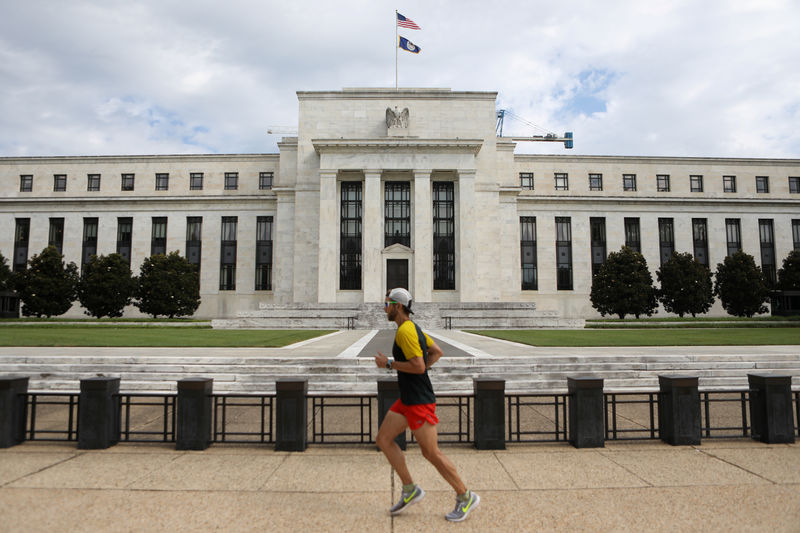(Bloomberg) -- Sign up for the New Economy Daily newsletter, follow us @economics and subscribe to our podcast.
Federal Reserve officials largely stuck to their script this week that the burst of inflation the U.S. is seeing as the pandemic recedes will prove temporary.
Some of them aren’t so sure, which is why they see a need for higher interest rates as soon as next year. But the coalition around Fed Chair Jerome Powell’s view that the surge in prices will fade appears to be intact.
Remarks by numerous officials since the U.S. central bank’s June 15-16 meeting show the debate over how long inflationary pressures will last is dividing officials into two camps.
Powell told lawmakers on Tuesday that “a pretty substantial part or perhaps all of the overshoot in inflation comes from categories that are directly affected by the reopening of the economy,” and should therefore be expected to dissipate over the course of the year.
That view was echoed by another member of the central bank’s leadership team: New York Fed President John Williams, who said on Thursday that he anticipates inflation will head back toward their 2% target next year.
Hawkish Dots
Others, like St. Louis Fed President James Bullard -- and his counterparts in Atlanta and Dallas, Raphael Bostic and Robert Kaplan -- all cited the risk of persistent higher inflation in public appearances this week, arguing it would probably be appropriate to begin raising the central bank’s benchmark rate from its current near-zero level some time in 2022.
“The differences in terms of the outlook for monetary policy really depend on and reflect the differences in the outlook for inflation,” said Gregory Daco, head of U.S. macroeconomics at Oxford Economics in New York.
“Those who believe that there will be a sticky environment in terms of inflation -- and that what we’re seeing today is a sign of an environment in which inflation is going to remain much higher if policy remains as dovish as it is -- want to see a much tighter stance,” Daco said.
On June 16, at the conclusion of its latest two-day policy meeting, the FOMC startled investors when it published updated quarterly projections showing 13 of 18 officials saw a likely need for higher rates by the end of 2023, with seven of them seeing a need to begin raising rates as soon as next year.
That marked a notable shift from the last time projections were updated in March, when 11 of 18 officials expected there would be no need for rate increases before 2024, and only four thought tightening would be needed in 2022.
Several top Fed officials, like Vice Chair Richard Clarida and Governor Lael Brainard, haven’t spoken publicly since the meeting.
Others -- like Fed Governor Michelle Bowman, Cleveland Fed President Loretta Mester, Boston’s Eric Rosengren, San Francisco’s Mary Daly and Richmond’s Thomas Barkin -- offered sanguine comments on the inflation outlook in public remarks this week but declined to reveal their interest-rate projections.
Minneapolis Fed President Neel Kashkari, who has long been the FOMC’s most outspoken dove, told Reuters in a June 18 interview that he penciled in no rate increases through the end of 2023.
Those in the 2022 camp have made it clear over in recent days that they are less confident that inflationary pressures will recede by next year. Bullard on June 18 told CNBC that he sees 2.5% inflation next year -- making his forecast the highest on the FOMC, according to the projections published on June 16.
“If that’s what you think is going to happen, then by the time you get to the end of 2022, you’d already have two years of 2.5-3% inflation,” Bullard said.
Labor Department reports on consumer prices for the months of April and May showed the highest monthly increases since 2009, topping forecasters’ estimates.
The pressures have been largely concentrated in used vehicles and categories associated with reopening of the economy, like airfares, as Americans have gotten vaccinated and begun returning to more normal, pre-pandemic lifestyles.
Even so, the inflationary decade of the 1970s looms large in the minds of many central bankers, who believe the takeaway from that experience is that the public’s expectations for inflation are what determine the actual rate of price increases in an economy. According to that view, the risk is that higher inflation now, whatever the source, could also lead to higher inflation in the future.
Fed officials possess a relatively wide range of views about what inflation will be next year -- anywhere from 1.7% to 2.5%, according to the projections. But the documents published on June 16 also showed that 13 of 18 on the FOMC saw the risks to their inflation projections as weighted to the upside, marking the highest number since the central bank began publishing that data in 2011.
The other five saw the risks as broadly balanced in either direction. The FOMC’s vice chair, New York’s Williams, laid out both sides of the argument while speaking Monday with reporters.
“There are obviously upside risks to inflation,” Williams said.
But he added that there are also two downside risks which must be kept in mind as well: One is that the economic recovery could end up being slower than forecasters currently anticipate, and the other is that supply-chain bottlenecks leading to elevated vehicle prices could work themselves out more quickly than anticipated.
“Supply and demand will adjust over time. That time might be a couple years. We don’t know,” Williams said. “But if that happens quicker than you’d expect, then those price increases that pushed inflation up will actually pull inflation down next year.”
©2021 Bloomberg L.P.
